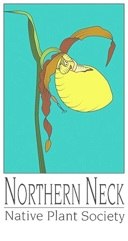Plant of the Month August 2024: Common Cut-leaf Coneflower
Common Cut-leaf Coneflower, Rudbeckia laciniata
2024 August Plant of the Month
Northern Neck Chapter of the Virginia Native Plant Society
Text and Photos by Betsy Washington
The composite flowers of Cut-leaf Coneflower with central green disk flowers surrounded by golden ray flowers
Common Cut-leaf Coneflower is a tall statuesque late summer-fall bloomer found throughout Virginia and stands above most perennials at heights 5 to 9 feet. Also known as Green-headed, Tall Coneflower, or Wild Golden Glow, it is widely distributed in open floodplain forests, alluvial swamps, seepage swamps, wet meadows, and along streams and rivers and even roadsides. This robust and fast-growing coneflower spreads by rhizomes to form large colonies in the moist soil it prefers. From mid-July to October these beauties are topped by masses of 2 – 4” wide golden, daisy-like flowers with a hemispherical central cone composed of light -green tubular disk flowers. Eight to 16 drooping golden ray florets surround this center cone adding an elegant look to this Black-eyed Susan relative. The flowers are held in large, loose clusters atop tall branching stems, creating a long-lasting show. The foliage is also distinctive and architectural. The lower and middle leaves, as the common name implies, are deeply ‘cut’ or divided into 5 or more, irregularly toothed lobes and may be up to 12” long, decreasing in size as they ascend the stem. The upper leaves are much smaller and may be 3-lobed or even entire with no lobes at all. As a winter bonus, the basal rosee of leaves is evergreen and persists through the winter adding structure and color to the garden while the roots stabilize the soil.
Cut-leaf Coneflower is adaptable and easy to grow; it tolerates part shade to full sun but prefers moist soils. It is oen found in the wild in partially shaded woodlands but tolerates full sun as long as the soil retains adequate moisture. Because of its natural preference for partially shady sites, it is a wonderful addition to a shady or woodland garden where its long-lasting, masses of golden blooms bring welcome color and life to the late season garden. It is a perfect choice for large gardens, damp meadows or the back of borders. The spreading rhizomes may be too aggressive for a small garden, so choose a spot where it has room to spread. It is ideal for naturalizing on slopes or wooded stream banks, where its spreading roots can stabilize the soil and prevent erosion. To increase or share plantings, or to control its spread, simply divide in spring or fall. This easy to grow perennial, tolerates occasional flooding, hot, humid summers, and thrives in a surprising amount of shade. It is rarely bothered by pests or diseases and is relatively deer resistant. Plants in shadier locations may flop or lean a bit while plants in drier sites tend to remain shorter or lose lower leaves. If height is an issue, you can cut the stems back by 1/3 to ½ in June to reduce ultimate size.
The flowers supply nectar and pollen to a variety of pollinators including both long and short tongued bees, as well as butterflies and moths, making it a perfect choice for pollinator or butterfly gardens. It is the host plant for the Silvery Checkerspot Butterfly and the Wavy-lined Emerald Moth and songbirds such as Goldfinches relish the seeds and add ornamental appeal to the fall and winter garden. The Native American Cherokee used the spring leaves as traditional greens so it has a place in a native edible garden.
We will have quite a few specimens of this lovely perennial (and many other wonderful pollinator favorites) for sale at our Annual Fall Plant Sale which will be held at Good Luck Cellars this year on Saturday, Sept. 7 from 12:00 to 3:00 and Sunday, Sept. 8 from 1:00 – 3:00. Light up your woodland garden, damp meadow or border, or even a wooded bank and delight in the long-lasting beautiful flowers, handsome foliage, and throngs of bees, butterflies and songbirds that will surely flock to your garden.
Cut-leaf Coneflowers attract a variety of pollinators like these Common Eastern Bumblebees
Cut-leaf Coneflowers thriving in a woodland garden
Textual Lobed foliage and glaucous stems
Pearl Crescent Nectaring on Cut-leaf Coneflower
Clusters of flowers create a dramatic Garden show
A colony showing the striking architectural form







